Amanda Forester's Blog
September 5, 2014
A Winter Wedding Release Party & Giveaway!
Much to my ch agrin, I realize it has been three years since my last blog post. Hmmmm, maybe I’m not keeping up? Sorry folks! I’ve been busy writing and now the final installment of the Marriage Mart – A Love for All Seasons trilogy has been published. Welcome to the world, A Winter Wedding!!
agrin, I realize it has been three years since my last blog post. Hmmmm, maybe I’m not keeping up? Sorry folks! I’ve been busy writing and now the final installment of the Marriage Mart – A Love for All Seasons trilogy has been published. Welcome to the world, A Winter Wedding!!
Miss Penelope Rose, the notorious Madame X , exclusive matchmaker to London’s elite, has made a modest fortune creating love matches for everyone but herself. Her toughest client yet, the Duke of Marchford, has commissioned her to find him a bride, but he is more interested in tracking down a spy than interviewing potential mates. Marchford is willing to do anything to find that spy, including announcing an impromptu engagement to force Penelope to stay close and help him catch the traitor. When Pen decides she has had enough, Marchford takes to wooing her to stay, including embracing that most perilous of holidays–Christmas! As Penelope and Marchford work together to uncover a deadly plot, they find falling in love is the most dangerous adventure of all.
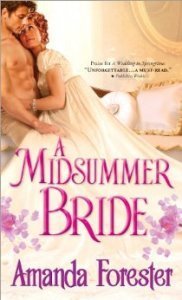 This series began for me with the unlikely attraction between the Duke of Marchford and Miss Penelope Rose. I knew that their romance would span over three books–they were very stubborn and it took a while to get them willing to say “I do”! We first met Penelope and Marchford in A Wedding in Springtime and learned how Penelope came to be the companion for Marchford’s grandmother (the Dowager Duchess of Marchford) and how Penelope and the dowager began a matchmaking service under the name of Madam X.
This series began for me with the unlikely attraction between the Duke of Marchford and Miss Penelope Rose. I knew that their romance would span over three books–they were very stubborn and it took a while to get them willing to say “I do”! We first met Penelope and Marchford in A Wedding in Springtime and learned how Penelope came to be the companion for Marchford’s grandmother (the Dowager Duchess of Marchford) and how Penelope and the dowager began a matchmaking service under the name of Madam X.
In A Midsummer Bride, they barely survived a house party Marchford arranged to flush out traitorous spies sent to infiltrate the haute ton. Penelope became indispensible to him in his investigative work, and perhaps even something more. And of course in A Winter Wedding Penelope and Marchford are on the hunt for the spymaster concealed in plain sight in London society.
I’m thrilled to say the books have entered the world to critical acclaim, each receiving a Starred 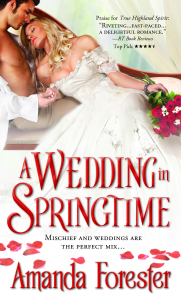 Review from Publisher’s Weekly!
Review from Publisher’s Weekly!
Forester’s third wedding-themed Regency-era novel is pure ambrosia… Readers will delight in one of Forester’s happiest offerings to date. ~ Publisher’s Weekly
Since I have neglected to host a release party for the first two books in the series, I will be giving away the entire trilogy of books to one lucky commenter! Marchford and Pen work together to track down spies, becoming something of secret agents themselves in their investigations, so who is your favorite fictional secret agent or investigator? Are a James Bond fan? Sherlock Holmes? Nancy Drew? Or maybe even Perry the Platypus! Comment for a chance to win all three books! (shipping limited to U.S. and Canada).
November 1, 2011
HIGHLANDER'S HEART Release Party
 I am so pleased to announce my second book, THE HIGHLANDER'S HEART is finally being released today! Yay! The crowd goes wild!!
I am so pleased to announce my second book, THE HIGHLANDER'S HEART is finally being released today! Yay! The crowd goes wild!!
It is wonderful my characters are finally seeing the light of day, so to speak. I enjoy all my characters, but David Campbell comes the closest to a man I might I actually fall for. Is it wrong to admit a small crush on my hero? He is steady, prayerful, and selfless in his concern for the welfare of his clan. He also looks smoking hot in a kilt!
I did a lot of research to find just the right name for my hero. I researched the clan histories and locations to find just the right fit. The powerful Campbell clan, located in Western Scotland, was perfect. Then I had to find a first name. I searched records which listed the names of the clan leaders and high ranking officials in the 14th century. The name 'David' was commonly in use, in fact it also was the name of the king of Scots at the time. 'David' also seemed to fit well with the surname of Campbell.
All you Freudians will smile knowingly when I confess that it wasn't until the end of the manuscript, a manuscript that took me almost an entire year to write, that I realized I actually knew a real David Campbell. He was a totally cute boy I was mad about in high school. Hmmm…coincidence?
Did you ever have a "Freudian slip" where you accidently revealed what you really meant, rather than what you meant to say? Do tell!
Comment on this blog for a chance to win a copy of both THE HIGHLANDER'S SWORD, and THE HIGHLANDER'S HEART. I'd also love hearing from you on facebook, or twitter.
HIGHLANDER’S HEART Release Party
 I am so pleased to announce my second book, THE HIGHLANDER’S HEART is finally being released today! Yay! The crowd goes wild!!
I am so pleased to announce my second book, THE HIGHLANDER’S HEART is finally being released today! Yay! The crowd goes wild!!
It is wonderful my characters are finally seeing the light of day, so to speak. I enjoy all my characters, but David Campbell comes the closest to a man I might I actually fall for. Is it wrong to admit a small crush on my hero? He is steady, prayerful, and selfless in his concern for the welfare of his clan. He also looks smoking hot in a kilt!
I did a lot of research to find just the right name for my hero. I researched the clan histories and locations to find just the right fit. The powerful Campbell clan, located in Western Scotland, was perfect. Then I had to find a first name. I searched records which listed the names of the clan leaders and high ranking officials in the 14th century. The name ‘David’ was commonly in use, in fact it also was the name of the king of Scots at the time. ‘David’ also seemed to fit well with the surname of Campbell.
All you Freudians will smile knowingly when I confess that it wasn’t until the end of the manuscript, a manuscript that took me almost an entire year to write, that I realized I actually knew a real David Campbell. He was a totally cute boy I was mad about in high school. Hmmm…coincidence?
Did you ever have a “Freudian slip” where you accidently revealed what you really meant, rather than what you meant to say? Do tell!
Comment on this blog for a chance to win a copy of both THE HIGHLANDER’S SWORD, and THE HIGHLANDER’S HEART. I’d also love hearing from you on facebook, or twitter.
April 3, 2010
Easter Eggs and Other Medieval Easter Traditions
While Christmas is huge holiday for Christians in modern times, for medieval Christians it was Easter that was the biggest celebration. Not only did it have the greatest religious significance, but after fasting for almost 6 weeks, people looked forward to Easter with great anticipation!
Preparations for Easter began 40 days (not including Holy Week) prior to Easter with Ash Wednesday. On this day, the penitent would make a public statement of their repentance by having the sign of the cross placed on their foreheads with ashes. This was the beginning of Lent, which in the middle ages and medieval period was a serious time of fasting and repentance. This generally meant eating only one meal per day (except for the very young, aged, or sick). Both rich and poor were expected to forego earthly pleasures, such as meat, dairy products, fruit, and eggs. Therefore eggs were hard boiled during lent to preserve them for Easter – read more on the Easter egg below.
Holy Week
The Lenten observances culminated the week before Easter or Holy Week. During these days special services were held. In particular on Maundy Thursday the last supper of Jesus was remembered, which was the celebration of the Lord's Supper in churches, also called communion or the Eucharist. On Good Friday people remembered the death of Jesus on the cross. Some would participate in the ceremony of 'creeping to the cross' where believers would approach the crucifix in the church on bended knee.
The Tenebrae (Latin for "darkness") service was held Maundy Thursday, Good Friday, and Holy Saturday. These three days before the feast of the resurrection or Easter were also called the Triduum. The Tenebrae service was conducted late at night after midnight or early morning, so that is was held in darkness. The church would be lit by a single candle stand called the 'hearse', which held 15 candles in an inverted 'V' shape. During the service, verses would be chanted from Psalms, Lamentations, and Jeremiah. After each section, one candle would be extinguished, until only the single candle on top remained, representing the light of Christ. This candle would then be placed below the altar, casting the church in total darkness. Suddenly a loud noise (called the strepitus and generally made by slamming a book closed or against a pew) would shock the parishioners. This noise represented the earthquake that occurred after Christ's death by crucifixion. The single candle would be returned, representing the resurrection of Christ, and the congregation would leave in silence. During the service a typical verse chanted would be the following:
Have mercy on me, O God, according to your unfailing love; according to your great compassion blot out my transgressions. Wash away all my iniquity and cleanse me from my sin. Psalm 51:1-2
Except that in medieval times, the only scripture used was the Latin Vulgate Bible. Despite the fact that only priests or the highly educated understood Latin, all scripture was spoken in that language. So a medieval parishioner would have heard the following:
miserere mei Deus secundum misericordiam tuam iuxta multitudinem miserationum tuarum dele iniquitates meas multum lava me ab iniquitate mea et a peccato meo munda me (This is the same verse as above, but they did not have the Bible divided into verses back then, or use capitalization or punctuation with Latin – all part of the fun challenge of studying scripture back then!)
 Understand the Latin text? Most folks in medieval churches didn't either, which set the stage for the reformation… but that's another post. To help the common folk understand what was going on, stained glass windows were created which showed the Biblical stories in pictorial form. Also, passion plays became popular, where members of the laity would act out the story of Jesus' death and resurrection using language and images everyone could understand. These medieval passion plays are still being performed in Europe.
Understand the Latin text? Most folks in medieval churches didn't either, which set the stage for the reformation… but that's another post. To help the common folk understand what was going on, stained glass windows were created which showed the Biblical stories in pictorial form. Also, passion plays became popular, where members of the laity would act out the story of Jesus' death and resurrection using language and images everyone could understand. These medieval passion plays are still being performed in Europe.
Easter
Easter morning was a special one of celebration in medieval times. Church services usually began at dawn. Parishioners would often gather outside the church to watch the sun rise and sing hymns of joy. Afterwards, they would be led into the church by the priest. During the Easter service, the resurrection of Christ was celebrated along with the good news that through his sacrifice all sins were forgiven, and to all who believed was given the promise of life after death.
After almost six weeks of fasting and penitence, Easter day was welcomed with joy. If a person could afford it, they would wear new clothes. For some, this may be the only time they received a new garment. For the wealthy and titled, an Easter Court was often held, which involved an amazing feast including all the items they had been denied during lent.
Some medieval Easter customs remain to this day. The eggs that had been set aside and hard boiled during lent became a treat for Easter, hence the origin of the Easter egg. Eggs may even have been decorated and hid for children to find. Eggs were seen as symbols of new life and the resurrection of Jesus from the cross, so they were hidden to represent the apostles going to the tomb and finding the risen Lord. The custom of dying eggs and having Easter egg hunts remains a favorite tradition in many families to this day!
to find. Eggs were seen as symbols of new life and the resurrection of Jesus from the cross, so they were hidden to represent the apostles going to the tomb and finding the risen Lord. The custom of dying eggs and having Easter egg hunts remains a favorite tradition in many families to this day!
Have a blessed Easter!
March 26, 2010
First Line Contest Winner!
Thank you everyone who entered! It takes a lot of guts to enter a contest and put yourself "out there" for others to evaluate. So kudos to all of you who gave it a go! Fortunately I didn't have to pick the winner, because look at all these fabulous entries!
Let's start with the three runners-up who all win a copy of THE HIGHLANDER'S SWORD! They are:
Victoria Roberts for "Sometimes being a Highland Laird is a royal pain in the arse."
Kerri Nelson for "The day my father killed me, I'd just met the girl of my dreams."
Jennifer Hilt for "Like a fox in a henhouse, the Duke prowled among the marriageable virgins at the soiree; unlike the fox however, the Duke had no appetite for feather brains."
And the Grand Prize winner of a copy of THE HIGHLANDER'S SWORD and a three-chapter critique from the totally fabulous New York literary agent Barbara Poelle is:
Crista McHugh for "Mr. Cooper, I'd like for you to ruin me."
Congratulations everyone! Please let me know when your books are published so I can run out and get myself a copy!!
March 16, 2010
First Line Contest–Win a Critique from NY Agent Barbara Poelle!
To celebrate my debut novel, THE HIGHLANDER'S SWORD I am sponsoring a first line contest for historical romance writers – and the grand prize is a three chapter critique from my agent, the utterly brilliant Barbara Poelle of the Irene Goodman Literary Agency! She really helped me improve my writing, and without even making me feel like a complete dork – now that's talent. She also knows what sells!
Writing the first line of the book is a challenge for me. I anguished over that first paragraph and especially the first line. It has to set the right tone. It has to draw the reader in. That's a lot of pressure for one poor little sentence! Here's the first line from THE HIGHLANDER'S SWORD:
"If they caught him, he would hang."
I'm totally impressed with those who can write great first lines – so here is your chance to shine! Entering is easy peasy. Just comment on this blog with the following:
Your Name
Title of your historical manuscript
First Line of your historical manuscript
Era you are writing in (Medieval, Regency, etc.)
Entries must be received by 3-20-10. I'll choose the top three entries and Barbara will choose the winner. The top three will receive a signed copy of THE HIGHLANDER'S SWORD and the winner will receive a three chapter critique of their manuscript from Barbara Poelle! Woo hoo!
So… what's your line?
Good luck!!!
March 10, 2010
And the winner is…
Thank you everyone who voted for the Dueling Videos for THE HIGHLANDER'S SWORD. It was a completely new experience for me to try to make videos (ok, my husband did most of the work), but turned out to be a lot of fun!
I received a lot of positive feedback for both videos and the voting was tied for quite a while. However, in the end the winning video with 52% of the vote was… the more serious/traditional video. I love the moody music in this one and I think it tells the basic storyline of Lady Aila who finds herself suddenly married to MacLaren, a Highland warrior. Here is our winner:
Since they were so close, here is the 2nd place video with 48% of the vote. This one reveals some of the humor in the book and tells the story through the eyes of MacLaren's best friend Chaumont, a wise-cracking, flirtatious, French knight.
If you liked the music is either of the videos check out Rathkeltair. Second only to Highlanders in kilts, I love me some celtic rock!
AND, as promised, a signed copy of THE HIGHLANDER'S SWORD will go to one lucky randomly selected voter. And the winner is… Renee D! Congratulations!
Amanda Forester
October 9, 2009
How To Fall In Love, Medieval Style
 Let's suppose you find yourself transported back to medieval times and now you are looking for a little romance (which is of course the main purpose for going back in time). But what are the rules of the game? What is the social etiquette of the day surrounding love? Today we'll review some commonly held modern day beliefs about love and evaluate them from a medieval perspective. Please note: these rules apply only to noble ladies, since I'm assuming you didn't go back in time to be a peasant!
Let's suppose you find yourself transported back to medieval times and now you are looking for a little romance (which is of course the main purpose for going back in time). But what are the rules of the game? What is the social etiquette of the day surrounding love? Today we'll review some commonly held modern day beliefs about love and evaluate them from a medieval perspective. Please note: these rules apply only to noble ladies, since I'm assuming you didn't go back in time to be a peasant!
BELIEF: Before you get married, you should date different people until you find your soul mate and fall in love.
FALSE: In medieval times you would spend about 3 nano-seconds after childhood before you were married…at the age of twelve. No sex and the single girl for you.
BELIEF: Your parents would be interested in finding you a good match, a kind man who would treat you well and be someone you could eventually fall in love with.
FALSE: Particularly for the nobility, marriages were arranged based on wealth, inheritance, family status, and political ambitions. The feelings of the persons involved were not a consideration. While occasionally these marriages developed into love matches (like in my novels – oh yeah), often a medieval lady was matrimonially entangled with a less than desirable mate. The laws giving medieval men license to beat their wives may not have increased the likelihood of wedded bliss.
BELIEF: You should look for a lover who is kind and respectful, someone honorable, who is not afraid to defend you if the need should arise.
TRUE: In its romanticized ideal, courtly love ennobled the knight to seek his lady's favor by being honorable, brave, courteous, and charming. Never would he brawl or act unseemly in the presence of his lady. The love-struck knight may even be emboldened to take on great acts of courage and daring in her name.
BELIEF: You should expect your husband to treat you with love and respect.
FALSE: In this age of chivalry, courtly love was seen as love for its own sake, without regard to family, or fortune. Thus, true love could only exist between partners who were NOT married to each other. And since essentially all ladies were married, this meant a romance between a knight and a lady married to someone else. In fact, the illicit nature of the relationship was seen as a fundamental to the allure.
Around 1175, Andreas Capellanus wrote De Amore (Concerning Love) for Countess Marie de Champagne, who theoretically held "courts of love" in which she tried cases of amore. Capellanus writes that married people simply cannot love each other since the act of marriage would destroy all possibility for love. (Hmmm, some modern folks might share that belief!)
"It is clearly known that love cannot claim a place between husband and wife… Love is nothing other than an uncontrolled desire to obtain the sensual gratification of a stealthy and secret embrace. Now I ask you: what stealthy embrace could take place between a married couple…?"
In one of Capellanus' stories, a woman spurns the advances of one knight because she is already engaged in a romantic affair with another man. Through a change of circumstances she is married to her lover. The spurned knight then demands that she accept his amorous advances since she clearly can no longer be in love with her former lover, now husband. His case is upheld by Countess de Champagne's fictional court and the lady is advised to take the knight as a lover!
BELIEF: If you do engage in an extramarital affair, you should keep the liaison secret.
TRUE: Not only did the medieval church view "courtly love" as nothing short of adultery but the law was also not on the side of the errant lovers, hence the need for secrecy. In the rein of France's Philip the Fair, two nobles accused of adultery with the wives of King Philip's sons were castrated, dragged through the town, and hung as adulterers and traitors of their lords.
On that happy note, I bid you all best of luck in your romantic adventures. May you find the love you seek, though perhaps not of the medieval variety!
References:
Gies,J & Gies,F. Life in a Medieval Castle. HarperCollins, New York. 1974.
Capellanus, NF. Courtly Love. Found in: Canton. The Medieval Reader. HarperPerennial, New York, 1995.
Tuchman, BW. A Distant Mirror: the Calamitous 14th Century. Ballantine Books, New York, 1978.
August 17, 2009
How To Undress Your Knight in Shining Armor
 Suppose you're a 21st century gal who is suddenly transported to medieval times (yes, I'm sure this happens all the time). You meet your knight in shining armor and now it is time to…well, get to know each other better. Unfortunately, he is encased in the world's largest chastity belt and you've neglected to pack your bolt cutters. So how do you pry your knight out of his metal suit?
Suppose you're a 21st century gal who is suddenly transported to medieval times (yes, I'm sure this happens all the time). You meet your knight in shining armor and now it is time to…well, get to know each other better. Unfortunately, he is encased in the world's largest chastity belt and you've neglected to pack your bolt cutters. So how do you pry your knight out of his metal suit?
Fear not, his squire got him into his harness (suit of armor) and you're going to get him out. If your knight is armed in full plate "cap-a-pie" (an old French saying meaning "head to foot") then you have time warped into the mid-fifteenth century. Despite looking like an impossible burden, most suits of armor were surprisingly flexible and weighed 45-55 pounds, about what today's infantryman carries. Unfortunately, this armor was exceedingly hot and many a knight survived the battle only to die later of heat stroke or suffocation. So let us begin to extricate your man post haste.
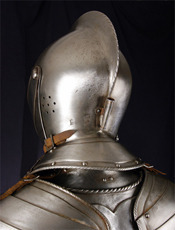 The first step is to start with the helmet. Look around the back to find leather straps and buckles that attach the wrapper, a metal piece in front of the helmet, to the armet (the rest of the helmet). Underneath, your knight may be wearing a rather goofy looking quilted bonnet tied under his chin. Never fear, this is easily removed and serves to prevent brain damage from occurring during combat (a knight who can recall his own name is always preferable to one who can not). Now you can step back and take a good look. If his visage is appealing, give him a saucy wink and continue on.
The first step is to start with the helmet. Look around the back to find leather straps and buckles that attach the wrapper, a metal piece in front of the helmet, to the armet (the rest of the helmet). Underneath, your knight may be wearing a rather goofy looking quilted bonnet tied under his chin. Never fear, this is easily removed and serves to prevent brain damage from occurring during combat (a knight who can recall his own name is always preferable to one who can not). Now you can step back and take a good look. If his visage is appealing, give him a saucy wink and continue on.
The gauntlets should be easy to remove by slipping them off, possibly with a strap at the inner forearm. Next is the armor on the arms, called the vambrace, which is actually in three pieces covering the shoulders, elbows, and forearms. The shoulders were particularly vulnerable to attack from sideways hits and downward blows that glanced off the helmet. Thus, the pauldron, or shoulder armor, was often substantial, giving your knight that husky linebacker look. To remove, the shoulder plates were tied to the top of the shoulder using waxed leather laces, which attached the pauldron to the arming doublet worn underneath. The pauldron was also strapped under the arm. The rest of the vambrace, an elbow piece called a couter and the lower cannon that encased the forearm, was attached the same way, tied to the arming doublet and strapped around the arm.
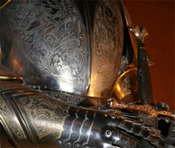 Once the arm defenses are removed, you come to the cuirass, which covers the chest and back. The steel plate armor could be formed so it followed the fashion of the day and was often ornately decorated. Since your knight has spent a considerable sum on his armor, take a moment to admire the craftsmanship and show him you appreciate the cost.
Once the arm defenses are removed, you come to the cuirass, which covers the chest and back. The steel plate armor could be formed so it followed the fashion of the day and was often ornately decorated. Since your knight has spent a considerable sum on his armor, take a moment to admire the craftsmanship and show him you appreciate the cost.
The cuirass in the 15th century was made of several pieces to allow movement and was hinged together on the left side so it can be removed in one piece. The left side of a knight was more likely to be hit, so the straps holding it together will be found on the right. Undo the buckles and the entire unit should slide off. A thick iron chain mail collar called a standard, used to protect the neck, can be removed over the head.
The leg defenses are easy to remove as they are simply strapped in the back of the leg. The cuisse protects the thigh and may also be laced at the top to the arming doublet. Moving down the legs, the poleyn covers the knee, the greave covers the shin, and the sabaton covers the foot. Once these are removed your knight should be looking a bit more human and a lot less cy-borg.
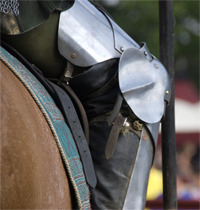 Under all this armor, your knight will be wearing an arming doublet and long woolen hose, much like stockings, that have built in leather soles at the bottom of the feet for shoes. The arming doublet has special leather laces fitted with metal tips or "points" with which to attach the pieces of the armor. The doublet also has gussets or sections of chain mail along the inside of the arms to protect places that are not covered by plate when fully armed. A chain mail skirt will be tied or "pointed" to the arming doublet. This skirt serves to protect the knight's private parts…let us hope it has done its job well.
Under all this armor, your knight will be wearing an arming doublet and long woolen hose, much like stockings, that have built in leather soles at the bottom of the feet for shoes. The arming doublet has special leather laces fitted with metal tips or "points" with which to attach the pieces of the armor. The doublet also has gussets or sections of chain mail along the inside of the arms to protect places that are not covered by plate when fully armed. A chain mail skirt will be tied or "pointed" to the arming doublet. This skirt serves to protect the knight's private parts…let us hope it has done its job well.
The woolen hose is tied at the top to the arming doublet. These can be untied and removed revealing linen drawers, like the modern day boxer shorts. The doublet can be untied in front uncovering a loose fitting linen shirt. Once you have removed the shirt you will have your knight in discarded armor wearing nothing more than shorts and a smile. I think you can take it from here!

Please note: Man in picture is representational only. Actual results may vary.
References:
Gravett, C. (1996). The World of the Medieval Knight. Peter Bedrick Books, New York.
Wise, T. (1976). Medieval Warfare. Osprey Publishing Ltd., London.
Also check out a Pictorial Glossary of Armor to see pictures of many of the armor pieces described above.
Amanda Forester's Blog
- Amanda Forester's profile
- 325 followers




